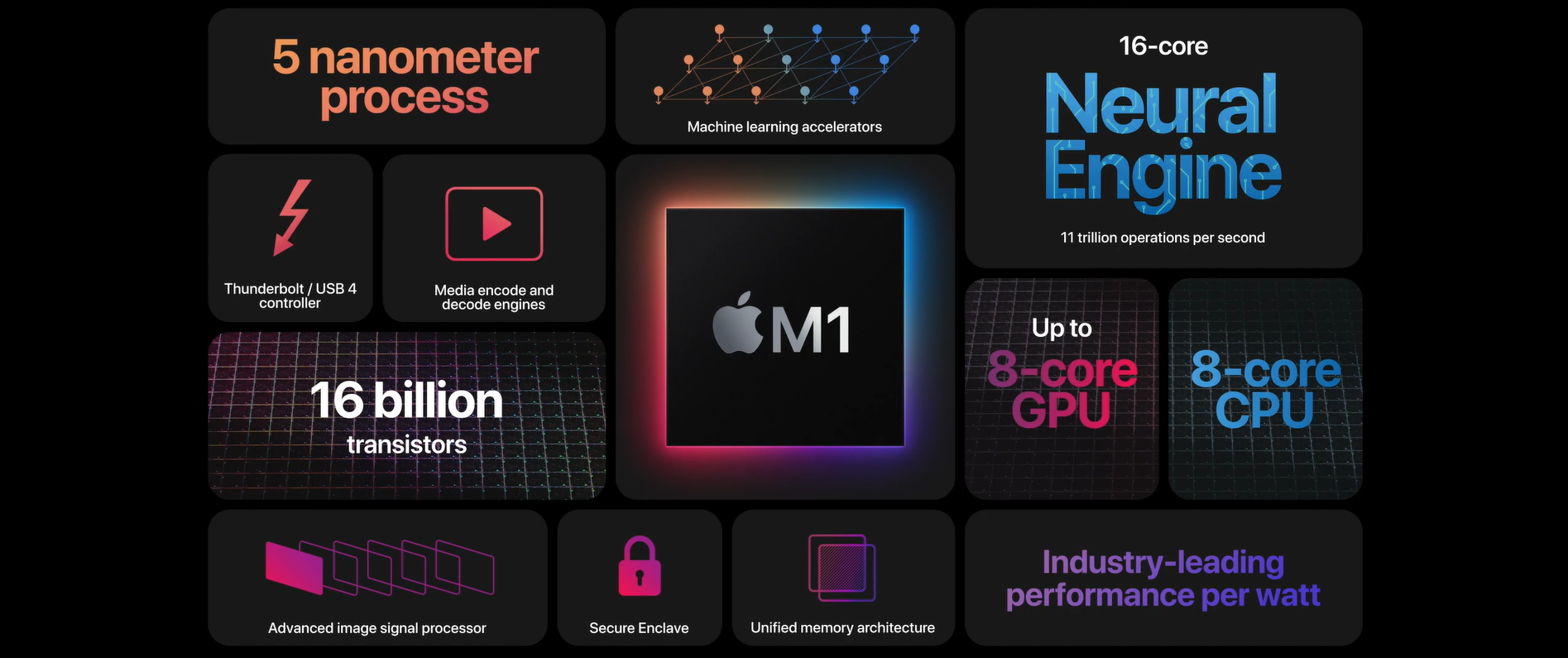Apple’s gone and done it — by which we mean it has announced its own processor, the M1. Because Apple doesn’t go for very descriptive names (it’s a thing for them), explaining the M1 goes a little something like this:
Apple’s made the M1 as a processor replacement, one that will eventually transition to the company’s whole product line. It’s an integrated system-on-chip (SoC) that looks a lot like its existing mobile processors, at least in terms of architecture. In terms of performance… well, Apples making some serious claims. Like, seriously serious. And we kinda believe them. We’re still gonna test it. But we kinda believe them.
One small step for M1
 The M1 SoC uses Apple’s 5nm manufacturing process, comprises of 16 billion transistors and includes CPU, GPU, Neural Engine and Secure Enclave sections. The CPU features eight cores — a quad-core performance option, which Apple claims is the world’s fastest quad-core, and a quad-core efficiency section, which Apple claims offers the same performance as existing dual-core Intel MacBooks. That’s… slightly insane.
The M1 SoC uses Apple’s 5nm manufacturing process, comprises of 16 billion transistors and includes CPU, GPU, Neural Engine and Secure Enclave sections. The CPU features eight cores — a quad-core performance option, which Apple claims is the world’s fastest quad-core, and a quad-core efficiency section, which Apple claims offers the same performance as existing dual-core Intel MacBooks. That’s… slightly insane.
Going to pieces
 The integrated GPU features up to 8 cores, which means there are slower versions. Apple hasn’t elaborated on the less powerful options, though. They’ve got their best foot forward. And it really is ‘best’. The integrating graphics of the M1 runs at up to 2.6 teraflops while remaining low-power. You’ll see what we mean when you see the battery numbers for the new M1-toting Apple hardware.
The integrated GPU features up to 8 cores, which means there are slower versions. Apple hasn’t elaborated on the less powerful options, though. They’ve got their best foot forward. And it really is ‘best’. The integrating graphics of the M1 runs at up to 2.6 teraflops while remaining low-power. You’ll see what we mean when you see the battery numbers for the new M1-toting Apple hardware.
Oh yes, and Apple’s 16-core neural engine is supposedly capable of up to 11 trillion operations per second. Apple’s Secure Enclave is also supposed to be faster and more secure — but then, they would say that.
Software advantage
 But here’s the thing. It’s not enough that Apple’s claiming all sorts of hardware advantages. No, macOS Big Sur has also been optimised to work with M1 — which is a big deal. This is basically a custom chip, with the software custom-written to run on it. That’s a huge advantage over Windows, which has to work on a whole range of hardware. There are no optimised instructions there, it’s more of a generalised thing.
But here’s the thing. It’s not enough that Apple’s claiming all sorts of hardware advantages. No, macOS Big Sur has also been optimised to work with M1 — which is a big deal. This is basically a custom chip, with the software custom-written to run on it. That’s a huge advantage over Windows, which has to work on a whole range of hardware. There are no optimised instructions there, it’s more of a generalised thing.
Windows… is still for nerds (Window 7 forever!) but Apple’s walled garden may just be bearing some seriously impressive fruit. All the avenues are covered, from graphics to power management to security. When you don’t have to account for varied configurations, you can have a tighter, speedier system. There’s not much room for mucking around with customisation, particularly since Apple has integrated hardware and software so closely this time, but that’s kinda the point. You give up control so the thing goes faster. Whether that sounds good… well, that’s up to you.




